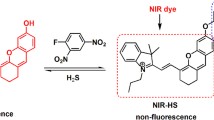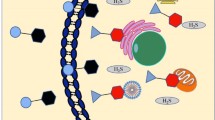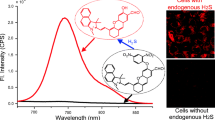Abstract
The selective detection of hydrogen sulfide in physiological and pathological processes has gained substantial attention in recent years. However, the real-time detection of hydrogen sulfide remains an elusive goal. In this work, a new type of hemicyanidin-based fluorescent “turn-on” probe NTR-HS (Ex = 680 nm, Em = 760 nm) was developed to detected H2S in a very short time (3 min). The fluorescence quantum yield is 0.15 and accompanied with a noticeable color change from violet to blue that can be used to detect H2S in the range 1.04 × 10−7–4 × 10−5 M with a limit of detection of 1.04 x 10-7 M. The NTR-HS probe was also used for imaging of endogenous hydrogen sulfide and mitochondrial localization in HCT116 and HeLa cells. The detection mechanism was studied through fluorescence, UV–Vis, NMR, and mass analysis. Notably, the probe was successfully used to imaging H2S in mice and locating hydrogen sulfide in the large intestine of mice.
Graphical abstract








Similar content being viewed by others
Data availability
All requests with regard to data and materials can be addressed to Xuejun Liu, liuxuejun@henu.edu.cn; Kuoxi Xu, xukx@henu.edu.cn.
Code availability
Not applicable.
References
Li HN, Fang YX, Yan JJ, Ren XY, Zheng C, Wu B, Wang SY, Li ZL, Hua HM, Wang P, Li DH (2021) Hydrogen sulfide capture: from absorption in polar liquids to oxide, zeolite, and metal–organic framework adsorbents and membranes. Trac-Trend Anal Chem 134:116117
Yang MW, Fan JL, Du JJ, Peng XJ (2020) Small-molecule fluorescent probes for imaging gaseous signaling molecules: current progress and future implications. Chem Sci 11:5127–5141
Butwong N, Srijaranai S, Luong JHT (2016) Lighting up ATP in cells and tissues using a simple aptamer-based fluorescent probe. Microchim Acta 183:1243–1249
Wang R, Gu X, Li Q, Gao J, Shi B, Xu G, Zhu T, Tian H, Zhao C (2020) Aggregation enhanced responsiveness of rationally designed probes to hydrogen sulfide for targeted cancer imaging. J Am Chem Soc 142:15084–15090
Wu L, Sun Y, Sugimoto K, Luo Z, Ishigaki Y, Pu K, Suzuki T, Chen HY, Ye D (2018) Engineering of electrochromic materials as activatable probes for molecular imaging and photodynamic therapy. J Am Chem Soc 140:16340–16352
Zou XJ, Ma YC, Guo LE, Liu WX, Liu MJ, Zou CG, Zhou Y, Zhang JF (2014) A lysosome-targeted fluorescent chemodosimeter for monitoring endogenous and exogenous hydrogen sulfide by in vivo imaging. Chem Commun 50:13833–13836
Wang J, Wen Y, Huo F, Yin C (2019) A highly sensitive fluorescent probe for hydrogen sulfide based on dicyanoisophorone and its imaging in living cells. Sens Actuators B 294:141–147
Gong DY, Zhu XT, Tian YJ, Han SC, Deng M, Iqbal A, Liu WS, Qin WW, Guo HC (2017) A phenylselenium-substituted BODIPY fluorescent turn-off probe for fluorescence imaging of hydrogen sulfide in living cells. Anal Chem 89:1801–1807
Mao GJ, Wei TT, Wang XX, Huan SY, Lu DQ, Zhang J, Zhang XB, Tan WH, She GL, Yu RQ (2013) High-sensitivity naphthalene-based two-photon fluorescent probe suitable for direct bioimaging of H2S in living cells. Anal Chem 85:7875–7881
Wang H, Li YN, Yang SX, Tian HY, Liang S, Sun BG (2019) Dual-function fluorescent probe for detection of hydrogen sulfide and water content in dimethyl sulfoxide. ACS Omega 4:10695–10701
Pak YL, Li J, Ko KC, Kim G, Lee JY, Yoon JY (2016) Mitochondria-targeted reaction based fluorescent probe for hydrogen sulfide. Anal Chem 88:5476–5481
Kang J, Huo F, Ning P, Meng X, Chao J, Yin C (2017) Two red-emission single and double ‘arms’ fluorescent materials stemed from ‘one-pot’ reaction for hydrogen sulfide vivo imaging. Sens Actuators B 250:342–350
Zhu HC, Liang CX, Cai XY, Zhang HM, Liu CY, Jia P, Li ZL, Yu YM, Zhang X, Sheng WL, Zhu BC (2020) Rational design of a targetable fluorescent probe for visualizing H2S production under Golgi stress response elicited by Monensin. Anal Chem 92:1883–1889
Yang L, Su YN, Geng YN, Zhang Y, Ren XJ, He L, Song XZ (2018) A triple-emission fluorescent probe for discriminatory detection of cysteine/homocysteine, glutathione/hydrogen sulfide and thiophenol in living cells. ACS Sens 3:1863–1869
Yang G, Wu L, Jiang B, Yang W, Qi J, Cao K, Meng Q, Mustafa AK, Mu W, Zhang S, Snyder SH, Wang R (2008) H2S as a physiologic vasorelaxant: hypertension in mice with deletion of cystathionine γ-lyase. Science 322:587–590
Li B, Mei H, Wang M, Gu X, Hao J, Xie X, Xu K (2021) A near-infrared fluorescent probe for imaging of endogenous hydrogen sulfide in living cells and mice. Dye Pigment 189:109231
Zhang WJ, Huo FJ, Yin CX (2019) Photocontrolled single-/dual-site alternative fluorescence probes distinguishing detection of H2S/SO2 in vivo. Org Lett 21:5277–5280
Zhou KY, Yang YT, Zhou TT, Jin M, Yin CX (2021) Design strategy of multifunctional and high efficient hydrogen sulfide NIR fluorescent probe and its application in vivo. Dyes Pigments 185:108901
Zhong KL, Chen L, Pan YX, Yan XM, Hou SH, Tang YW, Xue G, Li JR, Tang LJ (2019) A colorimetric and near-infrared fluorescent probe for detection of hydrogen sulfide and its real multiple applications. Spectrochim Acta A 221:117135
Wang JP, Wen Y, Huo FJ, Yin CX (2019) Based ‘successive’ nucleophilic substitution mitochondrial-targeted H2S red light emissive fluorescent probe and its imaging in mice. Sens Actuators B 297:126773
Zhao Q, Huo F, Kang J, Zhang Y, Yin C (2018) A novel FRET-based fluorescent probe for the selective detection of hydrogen sulfide (H2S) and its application for bioimaging. J Mater Chem B 6:4903–4908
Tang YH, Kong XQ, Liu ZR, Xu A, Lin WY (2016) Lysosome-targeted turn-on fluorescent probe for endogenous formaldehyde in living cells. Anal Chem 88:9359–9363
Wang YY, Yang CT, Xu S, Chen W, Xian M (2019) Hydrogen sulfide mediated tandem reaction of selenenyl sulfides and its application in fluorescent probe development. Org Lett 21:7573–7576
Li T, Yin CX, Chao JB, Zhang WJ, Huo FJ (2020) An ultra-fast, NIR, mitochondria-targeted fluorescent probe for sulfur dioxide based on benzopyrylium and its imaging of in living cells. Sens Actuators B 305:127336
Zhang Y, Yang H, Wei D, Zhang X, Wang J, Wu X, Chang J (2021) Mitochondria-targeted nanoparticles in treatment of neurodegenerative diseases. Exploration 1:20210115
Bae SK, Heo CH, Choi DJ, Sen D, Joe EH, Cho BR, Kim HM (2013) A ratiometric two-photon fluorescent probe reveals reduction in mitochondrial H2S production in parkinson’s disease gene knockout astrocytes. J Am Chem Soc 135:9915–9923
Ashton TD, Katrina A, Jolliffe B, Pfeffer FM (2015) Luminescent probes for the bioimaging of small anionic species in vitro and in vivo. Chem Soc Rev 14:4547–4595
Jin XL, Wu SP, She MY, Jia YF, Hao LK, Yin B, Wang LY, Obst M, Shen YH, Zhang YM, Li JL (2016) A novel fluorescein-based fluorescent probe for detecting H2S and its real applications in blood plasma and biological imaging. Anal Chem 88:11253–11260
Wang X, Sun J, Zhang WH, Ma XX, Lv JZ, Tang B (2013) A near-infrared ratiometric fluorescent probe for rapid and highly sensitive imaging of endogenous hydrogen sulfide in living cells. Chem Sci 4:2551–2556
Wu Z, Liang D, Tang X (2016) Visualizing hydrogen sulfide in mitochondria and lysosome of living cells and in tumors of living mice with positively charged fluorescent chemosensors. Anal Chem 88:9213–9218
Wu ZS, Li Z, Yang L, Han JH, Han SF (2012) Fluorogenic detection of hydrogen sulfide via reductive unmasking of o-azidomethylbenzoyl-coumarin conjugate. Chem Commun 48:10120–10122
Roberta P, Alessandro P, Enrico D (2018) Biochemical sensing with macrocyclic receptors. Chem Soc Rev 47:7006–7026
Tang YH, Ma YY, Yin JL, Lin WY (2019) Strategies for designing organic fluorescent probes for biological imaging of reactive carbonyl species. Chem Soc Rev 48:4036–4048
Wanderi K, Cui Z (2022) Organic fluorescent nanoprobes with NIR-IIb characteristics for deep learning. Exploration 2:20210097
Qian MS, Zhang LW, Pu ZJ, Xia J, Chen LL, Xia Y, Cui HY, Wang JY, Peng XJ (2018) A NIR fluorescent probe for the detection and visualization of hydrogen sulfide using the aldehyde group assisted thiolysis of dinitrophenyl ether strategy. J Mater Chem B 6:7916–7925
Yang Y, Zhao Q, Feng W, Li F (2013) Luminescent chemodosimeters for bioimaging. Chem Rev 113(1):192–270
Hammers MD, Taormina MJ, Cerda MM, Montoya LA, Seidenkranz DT, Parthasarathy R, Pluth MD (2015) A bright fluorescent probe for H2S enables analyte-responsive, 3D imaging in live zebrafish using light sheet fluorescence microscopy. J Am Chem Soc 137:10216–10223
Palanisamy R, Vignesh KK, Antony PB, Anna BC, Maciej M, Cheol SK, Chan HP, Princy MJ, Byung-Hyun P, Myung-Kwan H, Ae RK, Dong JY (2021) Simple colorimetric and fluorescence chemosensing probe for selective detection of Sn2+ ions in an aqueous solution: evaluation of the novel sensing mechanism and its bioimaging applications. Anal Chem 93:801–811
Zheng JR, Xu Y, Fan LX, Qin SH, Li H, Sang MM, Li RX, Chen HY, Yuan ZW, Li BW (2020) A Bioresponsive near-infrared fluorescent probe for facile and persistent live-cell tracking. Small 16:2002211
Li B, Gu X, Wang M, Liu X, Xu K (2021) A novel “off-on-off” fluorescent probe for sensing of Fe3+ and F− successively in aqueous solution and its application in cells. Dye Pigment 194:109637
Chang Y, Qin H, Wang X, Li X, Li M, Yang H, Xu K, Qing G (2020) Visible and reversible restrict of molecular configuration by copper ion and pyrophosphate. ACS Sens 5:2438–2447
Wang P, Fu J, Yao K, Chang Y, Xu K, Xu Y (2018) A novel quinoline-derived fluorescent “turn-on” probe for Cu2+ with highly selectivity and sensitivity and its application in cell imaging. Sens Actuators B 273:1070–1076
Wang XD, An L, Tian QW, Cui KL (2019) Recent progress in H2S activated diagnosis and treatment agents. RSC Adv 9:33578–33588
Funding
This work was supported by the Teacher Education Curriculum Reform Research Project of Henan Province (2020-JSJYZD-019).
Author information
Authors and Affiliations
Contributions
Bai Li: resources, writing, supervision, data curation. Minghui Wang: conceptualization, methodology, project administration, software. Xin Gu: data curation, visualization. Jiajia Chen: conceptualization, visualization. Xiaoyan Yang: review and editing. Xindi Yang: methodology, software. Xuejin Liu: review and editing, supervision, funding acquisition. Kuoxi Xu: Resources, writing—review and editing, supervision, data curation.
Corresponding authors
Ethics declarations
Ethics approval
All applicable international, national, and/or institutional guidelines for the care and use of animals were followed.
Consent to participate
Not applicable.
Consent for publication
Not applicable.
Conflict of interest
The authors declare no competing interests.
Additional information
Publisher's note
Springer Nature remains neutral with regard to jurisdictional claims in published maps and institutional affiliations.
Supplementary Information
Below is the link to the electronic supplementary material.
Rights and permissions
About this article
Cite this article
Li, B., Wang, M., Gu, X. et al. A hemicyanidin-based NIR fluorescent probe for detection of H2S and imaging study in cells and mice. Microchim Acta 189, 291 (2022). https://doi.org/10.1007/s00604-022-05374-7
Received:
Accepted:
Published:
DOI: https://doi.org/10.1007/s00604-022-05374-7




